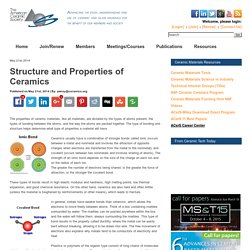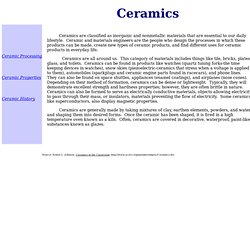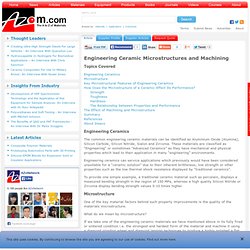

Sintering of ceramics [SubsTech] Dr.
![Sintering of ceramics [SubsTech]](http://cdn.pearltrees.com/s/pic/th/sintering-of-ceramics-substech-125572538)
Dmitri Kopeliovich Sintering (Firing) of ceramic materials is the method involving consolidation of ceramic powder particles by heating the “green” compact part to a high temperature below the melting point, when the material of the separate particles difuse to the neghbouring powder particles. The driving force of sintering process is reduction of surface energy of the particles caused by decreasing their vapour-solid interfaces. During the diffusion process the pores, taking place in the “green compact”, diminish or even close up, resulting in densification of the part, improvement of its mechanical properties.
Decrease of the porosity, caused by the sintering process, is determined by the level of the initial porosity of the “green” compact, sintering temperature and time. Sintering (firing) of pure oxide ceramics require relatively long time and high temperature because the diffusion proceeds in solid state. Applying pressure decreases sintering time and the resulted porosity. Sintering of Pressed Ceramic Components. Chemically Bonded Phosphate Ceramics. Recent Progress in Chemically Bonded Phosphate Ceramics. Chapter 1. Introduction. Chapter 1.

Introduction 1 .1 Historical Perspective Materials are so important in the development of civilization that we associate Ages with them. In the origin of human life on Earth, the Stone Age, people used only natural materials, like stone, clay, skins, and wood. When people found copper and how to make it harder by alloying, the Bronze Age started about 3000 BC. 1.2 Materials Science and Engineering Understanding of how materials behave like they do, and why they differ in properties was only possible with the atomistic understanding allowed by quantum mechanics, that first explained atoms and then solids starting in the 1930s.
Structure: At the atomic level: arrangement of atoms in different ways. Properties are the way the material responds to the environment. Processing of materials is the application of heat (heat treatment), mechanical forces, etc. to affect their microstructure and, therefore, their properties. 1.3 Why Study Materials Science and Engineering? Structure and Properties of Ceramics. May 21st, 2014 Published on May 21st, 2014 | By: pwray@ceramics.org The properties of ceramic materials, like all materials, are dictated by the types of atoms present, the types of bonding between the atoms, and the way the atoms are packed together.

The type of bonding and structure helps determine what type of properties a material will have. Ceramics usually have a combination of stronger bonds called ionic (occurs between a metal and nonmetal and involves the attraction of opposite charges when electrons are transferred from the metal to the nonmetal); and covalent (occurs between two nonmetals and involves sharing of atoms). The strength of an ionic bond depends on the size of the charge on each ion and on the radius of each ion. The American Ceramic Society. The American Ceramic Society. Ceramics - Engineer's Handbook.
Kyocera Industrial Ceramics Corporation. Kyocera has a wide range of advanced ceramic materials to offer.

Each one with its own unique characteristics designed to meet the requirements of many diverse applications. Some of the more widely used materials are described below. Click here for Material Specification Sheet. ALUMINA Alumina is the most widely used advanced ceramic material. It offers very good performance in terms of wear resistance, corrosion resistance and strength at a reasonable price. Applications include armor, semiconductor processing equipment parts, faucet disc valves, seals, electronic substrates and industrial machine components. SILICON NITRIDE Silicon nitride exceeds other ceramic materials in thermal shock resistance. Applications include various aerospace and automotive engine components, papermaking machine wear surfaces, armor, burner nozzles and molten metal processing parts. File:Glass reinforcements.jpg.
What is a Ceramic ? Ceramics are classified as inorganic and nonmetallic materials that are essential to our daily lifestyle.

Ceramic and materials engineers are the people who design the processes in which these products can be made, create new types of ceramic products, and find different uses for ceramic products in everyday life. Ceramics are all around us. This category of materials includes things like tile, bricks, plates, glass, and toilets. Ceramics can be found in products like watches (quartz tuning forks-the time keeping devices in watches), snow skies (piezoelectric-ceramics that stress when a voltage is applied to them), automobiles (sparkplugs and ceramic engine parts found in racecars), and phone lines. They can also be found on space shuttles, appliances (enamel coatings), and airplanes (nose cones). Engineering Ceramic Microstructures and Machining.
Topics Covered Engineering CeramicsMicrostructureKey Microstructural Features of Engineering CeramicsHow Does the Microstructure of a Ceramic Affect Its Performance?

Strength Toughness Hardness The Relationship between Properties and PerformanceThe Effect of Machining and MicrostructureSummaryReferencesAbout Insaco Engineering Ceramics The common engineering ceramic materials can be identified as Aluminium Oxide (Alumina), Silicon Carbide, Silicon Nitride, Sialon and Zirconia. These materials are classified as “Engineering” or sometimes “Advanced Ceramics” as they have mechanical and physical properties which lead to their application in many “engineering” environments. Engineering ceramics can service applications which previously would have been considered unsuitable for a “ceramic solution” due to their inherent brittleness, low strength or other properties such as the low thermal shock resistance displayed by “traditional ceramics”.
Microstructure What do we mean by microstructure? All about CeramTec: The Advanced Ceramic Experts. This great application diversity is possible thanks to advanced ceramics, also referred to as technical ceramics, engineering ceramics or industrial ceramics.

CeramTec International – English-language Website.